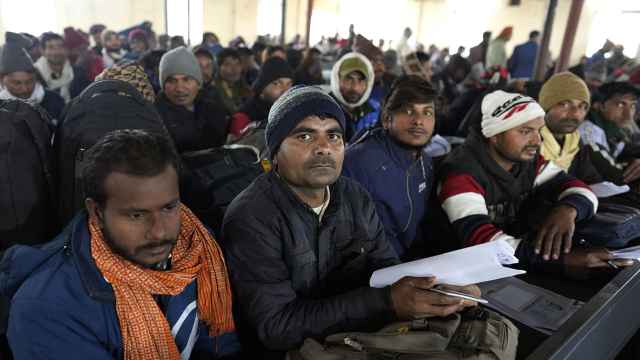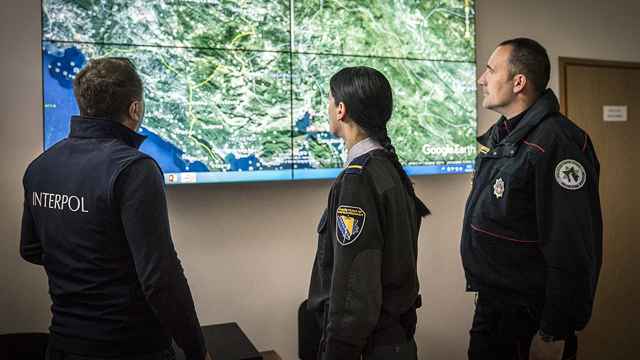In these turbulent times, when history is being created faster than it can be consumed, a visit to the Piskaryovskoye Memorial Cemetery in this terrific, tormented city brings perspective.
As winter snow was finally melting into spring on a recent Saturday, I was alone with the Soviet solemnity of this vast memorial, its granite statue of the Motherland, its eternal flame, its carved pledge that “no one is forgotten, nothing is forgotten,” and the mounds said to contain the remains of 490,000 of the 1 million people who perished in the World War II siege of Leningrad.
The very birth of this city was both triumph and tragedy. Peter the Great willed its ascension from swamps and marshland, where many died to realize his decree.
St. Petersburg was where tsars reigned, but also met terrible ends. Just there, noted a driver whisking me past the Field of Mars, “they” killed Alexander II; over there, in the adjacent Mikhailovsky Palace, Pavel.
Famously, there was Bloody Sunday and the revolution of 1905, followed by the two revolutions of 1917, the change of name to Petrograd, then after Lenin died, to Leningrad, the Stalinist terror, then World War II.
Of the many great artists of St. Petersburg, Fyodor Dostoevsky arguably captured it best. Knowing the imperial city’s vagaries, virtues and violence, he concluded that forced good, particularly good brought by shedding blood, will turn bad, and bring more death in its wake.
Indeed, tens of millions died at the hand of the Soviet state, through punishment, carelessness, deprivation.
The enormity of this destruction has been chronicled in fits and starts since Nikita Khrushchev first spoke of Stalin’s crimes in 1956. Uneven though the acknowledgement of the brutality remains, it contrasts with the silence that still surrounds similar destructive crimes in China — as the sanitized show of history in China’s new National Museum most recently showed.
Certainly, Soviets and Russians have known how to mourn their World War II dead and tend their legend of wartime unity and sacrifice, as Piskaryovskoye attests.
The huge memorial was opened in 1960 and exudes the brand of certainty of that era, when the horror of the war — and of Stalinist terror — had receded sufficiently to turn to glorifying the very real heroism of Russians in what all were taught and many believe was their finest hour.
The entrance to the mounds of mass graves is flanked by two pavilions. Their austerity contrasts with the pomp of words carved on their friezes: “To you, our courageous defenders: Your memory will live unfading in grateful Leningrad, which eternally owes its life to you; the immortal glory of heroes shall in posterity’s glory be multiplied.”
Inside one pavilion, an exhibit shows the siege. A father had brought a boy of about 4 or 5. “You see, my little son,” he said, “they had only that much bread each day,” just 125 grams. For such horror never to return, intones one caption, “Our children must know all this as we do.”
Outside waited today’s Russia. The traffic police had set up in front of the cemetery, flagging down drivers deemed to have violated the law. Alexei, 61, a former worker in a turbine factory who had driven me from the center, had sat watching as these officers pocketed the money handed over by drivers eager to keep their licenses.
“Thieves! They are thieves!” Alexei shouted angrily as we headed out of the Soviet suburbs around Piskaryovskoye, their crumbling apartment blocks and factories as ashen as winter sky. He meant not just the police, he emphasized, but especially the very top of Russian state and society.
How widely his anger is shared is unclear. Audible here was more the lament of those raised in the stagnant surety of the post-Stalinist Soviet Union, who really hoped for better when it crumbled in 1991 and today feel they lost even the cold comfort of certainty.
Each peek into the past unsettles further. The museum at the home of poet Anna Akhmatova is currently hosting a Finnish exhibit about the Soviet-Finnish wars of 1939-40 and 1941-44 — wars not part of the established Soviet narrative because the Finns proved fearsome foes, and many lives were lost: 85,000 Finns, 330,000 Russians.
As archives opened in the wave of glasnost in the 1990s are now sealed again by the authorities, new publications like Mark Solonin’s “June 25” argue that the massive attack on Finland on June 25, 1941, led directly to the siege of Leningrad and its huge toll.
Akhmatova, who knew nearby Finland from pre-1917 days when many St. Petersburg residents vacationed there, was one of the few European intellectuals to see Stalin’s attack on Finland in 1939 on a par with Hitler’s occupation of Paris or bombing of London.
In the permanent exhibit that chronicles her life, the Finns have installed pictures of these wars. On another floor, they built what looked like a Finnish apartment, peppering it with war images in unlikely places — the surface of dinner plates — to illustrate that memories of war never fade.
A Russian in her 50s was among the eager guides. The message she had absorbed, she said, was “that the Finns really took care of their veterans.” Unspoken, the clear reproach was that the Soviet state did not do the same.
Tragic letters sent by Russian soldiers to their families from the 1939-40 front — intercepted by the secret police and never delivered — are reprinted in the exhibition’s catalogue. “Valenka!” says one missive to a Ms. Panteleyeva in Leningrad, “everyone lives very well here. The barns are full of grain, and they have all different kinds of produce. In short, what we don’t have, they have. I’m so fed up I can’t look at anything.”
Several letters warn against believing the Soviet media. “Pay attention to this letter because the newspaper is just full of lies,” notes one. In the killing, said another, “my heart has turned to stone and my eyes have become wild like a beast’s.” To Anastasia Vlasova in Leningrad, her beloved Sasha wrote: “If I’m killed you won’t find out because there are lots of dead now. They lie right there in the forest, and then they are buried. So, Nastya, you and I will probably never see each other again.”
The exhibit — titled “What Was War Like?” — will show until St. Petersburg, once more, marks the end of World War II in Europe, on May 9, Russia’s Victory Day. As tumult rages on — in Africa, in Libya and the Middle East, in Japan — this city of so much splendor and suffering will again catch breath, still searching for the narrative of its past, its present, its future.
Alison Smale is executive editor of the International Herald Tribune, where this comment appeared.
A Message from The Moscow Times:
Dear readers,
We are facing unprecedented challenges. Russia's Prosecutor General's Office has designated The Moscow Times as an "undesirable" organization, criminalizing our work and putting our staff at risk of prosecution. This follows our earlier unjust labeling as a "foreign agent."
These actions are direct attempts to silence independent journalism in Russia. The authorities claim our work "discredits the decisions of the Russian leadership." We see things differently: we strive to provide accurate, unbiased reporting on Russia.
We, the journalists of The Moscow Times, refuse to be silenced. But to continue our work, we need your help.
Your support, no matter how small, makes a world of difference. If you can, please support us monthly starting from just $2. It's quick to set up, and every contribution makes a significant impact.
By supporting The Moscow Times, you're defending open, independent journalism in the face of repression. Thank you for standing with us.
Remind me later.





